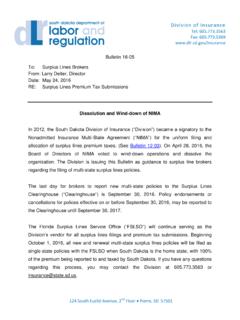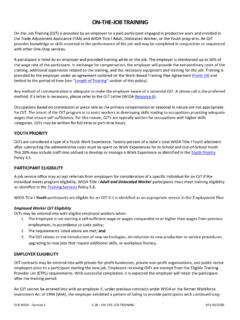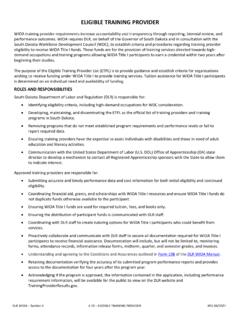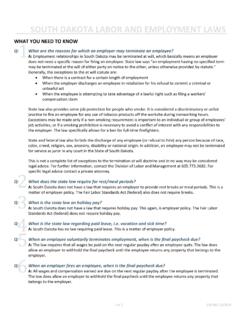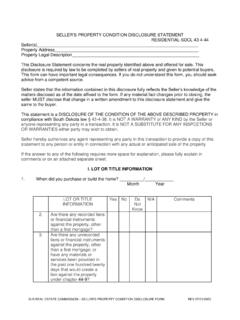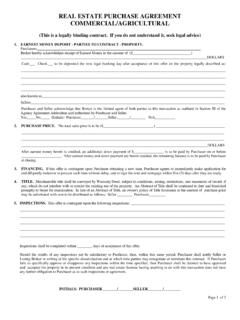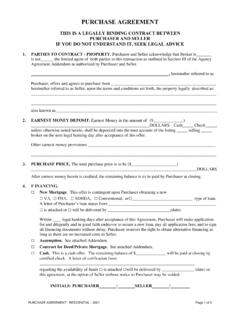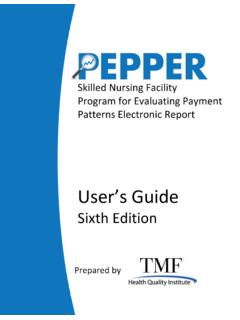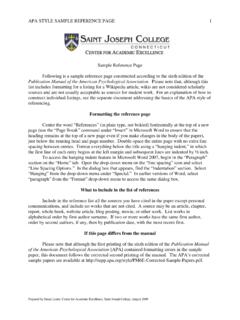Transcription of AMA Guides to Evaluation of Permanent Impairment – Sixth ...
1 2012 American Medical Association. All rights Guides to Evaluation of Permanent Impairment Sixth EditionSeptember 6, 2012 Presented by: Matthew Kremke, MBA, Director of AdvocacyJanet Thron, Senior Acquisitions EditorSlide Credits: Christopher Brigham, MDSenior Contributing Editor, AMA Guides , Sixth EditionMarjorie Eskay-Auerbach, MD, JDContributing Editor, AMA Guides , Sixth edition 2012 American Medical Association. All rights of the Guides1958-1971-1984-1988-1990-1993-2000 -2007 2012 American Medical Association. All rights In Perspective Impairment , a loss , reflects failure to prevent an injury or illness and/or to restore function Goal is an accurate, unbiased assessment of Impairment via efficient means assuring valid and reliable definition The Sixth edition uses the World Health Association (WHO) most current International Classification of Function (ICF) model and reflects the current standard; responding to opportunities for improvement from prior Editions.
2 MMI is not based on future issues or problems Future issues and problems are a social question not a medical question 2012 American Medical Association. All rights of Erroneous Impairment RatingsErroneousRatingBias TreatingPhysicianFailure toUnderstandAMA GuidesBias EvaluatingOrientedClinicalErrorsCausatio nErrorsNoAccountability 2012 American Medical Association. All rights edition Responded to Prior Concerns The 6thEdition Provides a comprehensive, valid, reliable, unbiased, and evidence-based rating system Has internal consistency in approach across chapters and body systems Incorporates principles consistent with clinical care (such as the premise that treatment including surgery should improve function) Has demonstrated improved inter-rater reliability Medical care changes with time, as do the Guides AMA Guides 6this an independent reproducible system Values will be similar to prior Editions, with exception of.
3 Joint Replacements (better functional results) Soft Tissue Injuries without ratable criteria (in certain situations may result in mild rating) Magnitude of errors will be less 2012 American Medical Association. All rights edition Innovations Conceptual framework of International Classification of Functioning, Disability and Health Focus on Diagnosis-Based Impairments, with consideration of function, physical examination, and clinical studies- which is how physicians deliver care 2012 American Medical Association. All rights Activity LimitationComplete Activity LimitationNo Participation RestrictionComplete Participation RestrictionContextual FactorsBody Functions and StructuresActivityParticipationEnvironme ntalPersonalNormal VariationComplete ImpairmentHealth Condition, Disorder or DiseaseBasis for Sixth edition the International Classification of Functioning, Disability and Health 2012 American Medical Association.
4 All rights on Ratings Changes in rating values: Providing Impairment ratings for conditions not previously ratable, yet resulting in loss Not providing additional Impairment for surgery (and other therapies intended to improve function) and thus decrease Impairment Adjustments for improved results ( joint replacements) 2012 American Medical Association. All rights edition Five the terminology, definitions and conceptual framework of disablement put forward by the International Classification of Functioning, Disability and Health (ICF) (WHO, 2001) in place of the current and antiquated ICIDH terminology (WHO, 1980) more evidence-based criteria are lacking, give highest priority to simplicity and ease of application conceptual and methodological congruity within and between organ system rating percentages that are functionally-based whenever possible 2012 American Medical Association.
5 All rights Rating is the problem? difficulties are reported? are the exam findings? are the results of the clinical studies?10 2012 American Medical Association. All rights Impairment Classes Class 0: No objective problem Class 1: Mild problem Class 2: Moderate problem Class 3: Severe problem Class 4: Very severe problemVast majority of Impairment ratings are based on diagnosis-based impairments, with adjustments (as applicable) for function, physical examination and clinical studies 2012 American Medical Association. All rights edition : SummaryGridClass 0 Class 1 Class 2 Class 3 Class 3 Diagnosis /CriteriaTable 17-6No problemMild problemModerate problemSevere problemVery severe problemNon-Key FactorGridGrade Modifier 0 Grade Modifier 1 Grade Modifier 2 Grade Modifier 3 Grade Modifier 4 Functional HistoryTable 17-6No problemMild problemModerate problemSevere problemVery severe problemPhysical ExamTable 17-7No problemMild problemModerate problemSevere problemVery severe problemClinicalStudiesTable 17-8No problemMild problemModerate problemSevere problemVery severe problemDiagnosis-Based ImpairmentAdjustment Factors Grade Modifiers 2012 American Medical Association.
6 All rights / PerceptionReality Sixth edition has caused confusion and concern Basis for concerns appears to be driven by lack of knowledge and Specific stakeholders: Stakeholders reluctant to change from a system they are familiar with, and Stakeholders who fear the values may be less and may favor approaches that are more ambiguous (resulting in more controversy and litigation). 2012 American Medical Association. All rights / PerceptionReality Stakeholders do not like the Sixth edition Most stakeholders have not yet had an opportunity to learn the Sixth edition , and therefore are biased opinions of certain stakeholders. Majority of physicians have a favorable opinion of the Sixth edition .
7 2012 American Medical Association. All rights Response to Sixth EditionStatementAgreementMore reasonable Impairment values66%Clearer process62%More internally consistent62%More reliable59%Errors Less Likely52%Easier to use41%Litigation Less Likely28% 2012 American Medical Association. All rights / PerceptionReality The Impairment values will be different. Impact not fully identified - no comprehensive study of impact of change in Impairment rating values. Need to consider whether comparing to prior observed ratings or corrected ratings. Impairment ratings follow precedent unless reason for change (different outcomes, erroneous approaches). Common conditions not previously ratable may be ratable in certain situations ( soft tissue, typically 1% - 3%).
8 Surgery itself typically does not increase Impairment , rather focus is on outcome. Fifth edition contained aberrant rating values. 2012 American Medical Association. All rights Rating Typical Case Examples WPID iagnosisThird Non-specific cervical (neck) pain0% or 5%(& ROM1)0% or 5%1% - 3%Cervical radiculopathy with fusion (resolved radiculopathy)7% or 9%(& ROM1)15% or 5%4 - 8%Lumbar radiculopathy (single level, persistent) non-surgical11%(& ROM1 2)10%10% - 14%Lumbar pain with single level fusion (no radiculopathy)8% of 10%(& ROM1)5%5% - 9%Lumbar pain with single-level fusion (with persistent single level radiculopathy)12%(& ROM1 2)10%10% - 14%Lumbar pain with multi-level fusion (no radiculopathy)10%(& ROM1)5%5% - 9%Lumbar radiculopathy with fusion (persistent single level radiculopathy)12%(& ROM1 2)
9 10%10% - 14%Average (assume of non-specific have ratable findings and mid-range values)9%8%8%1. Third Ed. Revised Spinal ratings per Table 53 Specific Disorders, combined with range of motion (ROM) deficits, if any. Notesubsequently spinal ROM was determined to lack validity and reliability as a basis to determine Neurological deficits per Tables 49, 10 and 11. Assuming hypothetical resulting in 2% WP, this is incorporated into rating value, Table 53 value is 2% WP less 2012 American Medical Association. All rights Rating Typical Case Ex. WPIT hird Digit Amputation Index at DIP joint5%5%5%Wrist Fracture residual symptoms and objective findings and/or functional loss with normal motion0%0%1% - 3%Wrist Fracture lack of 20 degrees flexion and of 20 degrees extension4%4%4%Lateral Epicondylitis residual symptoms without consistent objective findings0%0%0% - 1%Impingement Syndrome residual loss, functional with normal motion0%0%1% - 3%Carpal Tunnel Syndrome - confirmed, s/p release, symptoms and no objective findings0%0%0% - 2%Partial Medial Meniscectomy - symptoms, normal exam)0 4% & ROM (if any)1%1%Knee Arthritis moderate, 2 mm cartilage interval0 8% & ROM (if any)
10 8%6% - 10%s/p Total Knee Replacement fair result8%20%12% - 17%Average (based on mid-range for Third Rev., exclusive of ROM deficits)3%4%4% 2012 American Medical Association. All rights / PerceptionReality The error rate will be higher. Observations to date do not support this conclusion. Following errors common with the Third Revised, Fourth and Fifth Editions will not occur with the Sixth : Rating for strength loss (grip or clinical) Rating for subjective complaints in addition to the musculoskeletal rating ( pain, sex and sleep) Confusion with spine whether to rate on the basis of Diagnosis Related Estimate or Range of Motion 2012 American Medical Association.
